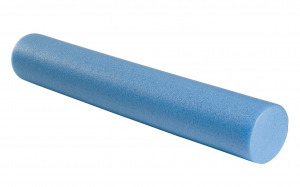There’s one in every gym, and potentially every household. The simple cure for our pains and strains, and the ultimate recovery tool…or so they tell us.
Over the last 20 years, foam rolling has become a thing. And now, it seems no one wants to leave home without it. Rolling around making love to it pre, peri, and post-workout, and crediting it for less soreness and increased mobility.
The question is:
How the heck did we survive before this magical cylinder came along?
We must’ve been stiff and sore all the time, never reaching full depth in the squat and taking forever to recover. We must’ve been full of knots and needed Self-Myofascial Release so bad, we would’ve paid someone to do it.
Well, not really. We stayed mobile by warming up and working our muscles to full range. And if we were super sore after a workout, we would stretch until we weren’t sore anymore.
Seems odd I know, but not as odd as spending 20 to 30 minutes before a session rolling around on a hard piece of foam thinking it’s doing more than a dynamic warm-up or a couple light-sets.
Sure, it may be superior to static stretching when performed pre-workout (because it doesn’t harm explosive performance), but that doesn’t mean it’s better for flexibility. And it may have an additive effect when performed AFTER a dynamic warm-up, but that doesn’t mean it should replace one.
Pre-Workout – Dynamic Warm-Up > Foam Rolling
Flexibility – Static Stretching > Foam Rolling
Realistically, the only thing foam rolling appears to be good for is skipping out on a massage bill, or giving lazy dudes the ability to say they warmed up. If you have tight muscles, move around; and if they’re chronically tight, find out what the problem is and get it fixed!
Generally speaking, any soreness and stiffness outside of training is because you sit too much and don’t move around enough. So either figure out how to sit less, or spend some extra time stretching your hamstrings and hip flexors, and strengthening your glutes and core. A couple extra activation drills and dynamic exercises before or after your training sessions are going to a do a lot more, a lot faster, than wasting 3 hours a week ‘rollin out’ the symptoms.
All that being said, don’t toss your giant rolling pin to the curb just yet. As here are 5 cool ways to incorporate the foam roller into your training:
Plank Rockers
Don’t get me wrong, performing this same exercise on a swiss ball is extremely effective. Largely because the ball can go in 4 directions, and you have the ability to ‘stir the pot.’ But, the Foam Roller puts you closer to the ground (less elevation), and gives you the opportunity to focus on maintaining a solid plank as opposed to ‘avoiding a tumble.’
Dig the feet in, fire the glutes, and challenge yourself by extending your arms as much as possible without losing your neutral spine.
Rollouts/Walkouts (Levels 1-3)
Not every gym has an ab wheel, but every gym has a foam roller. And after trying this exercise, you’ll probably opt for the foam roller anyways.
Aside from the ability to maintain a wider hand position, the biggest benefit with the foam roller is the opportunity to progress. Often times, the ab wheel or barbell variations stop at the knees; but the unique padding of the foam roller, lets you get up onto your feet.
Or shoot for more difficulty, by turning it into a walkout.
Plank Pull-Ins (Unilateral & Bilateral)
Similar to the Plank Rocker, one of the challenges with Plank Pull-ins on the swiss ball is staying on the darn thing. Maybe not so much for the intermediate or advanced, but definitely for beginners – who are typically the ones looking to do this exercise in the first place.
The other advantage of the foam roller is the ability to work from both your forearms and your hands.
And the ease of moving to a single leg option, with the opportunity to challenge the glutes and low back on the opposing limb.
Hamstring Curls (Unilateral & Bilateral)
Anyone that’s done Hamstring Curls on a Swiss Ball, knows they can be deceiving. Especially when they’re done properly with the hips fully bridged!
Minus the instability, the foam roller curls can be equally as challenging. And some might argue, more effective, as there’s the opportunity to concentrate on the bridge.
Likewise, the progression to one-leg is a lot smoother. Giving beginners the chance to increase their glute and hamstring strength without having to get circus certified first.
Supine Crucifix Stretch
Technically this isn’t an ‘exercise,’ and adding it to your training isn’t necessarily the best recommendation, but it’s worth mentioning as we talk about improving mobility and counteracting 21st century living.
If you sit at a desk, chronically hunch over on your smart phone, or blast your pecs twice as often as you train your back, you should find a way to incorporate this into your life.
The key is keeping your palms up, and only raising your arms higher once your forearms are fully relaxed on the floor.
As you’ll discover, it’s as much a pec stretch and posture corrector, as it is an opportunity to breathe, zone-out, and maybe even meditate.
Stay Lean!
Coach Mike
RELATED ARTICLES:


